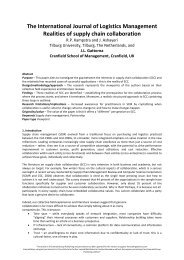customer segmentation based on buying and ... - John Gattorna
customer segmentation based on buying and ... - John Gattorna
customer segmentation based on buying and ... - John Gattorna
Create successful ePaper yourself
Turn your PDF publications into a flip-book with our unique Google optimized e-Paper software.
c<strong>on</strong>tinue to be a part of business operati<strong>on</strong>s, <strong>and</strong> literature indicates that competiti<strong>on</strong> is<br />
increasing <strong>and</strong> c<strong>on</strong>sumer dem<strong>and</strong>s are surely following this development. Therefore, there<br />
is a need to align RM within the supply chain strategy where the whole supply chain needs<br />
to operate efficiently <strong>and</strong> effectively <strong>and</strong> returns are no excepti<strong>on</strong> (Stock, 2009).<br />
The aim of the changes in delivery <strong>and</strong> return c<strong>on</strong>diti<strong>on</strong>s is to attract <strong>and</strong> create loyal <strong>and</strong><br />
repetitive <str<strong>on</strong>g>customer</str<strong>on</strong>g>s, thereby increasing sales. However, a liberal return policy increases<br />
returns (Wood, 2001). There is, however, no direct correlati<strong>on</strong> between increasing sales<br />
<strong>and</strong> maximizing profitability. Differences in service requirements might affect both sales<br />
<strong>and</strong> profitability. When utilizing a “<strong>on</strong>e size fits all” strategy correctly, <strong>on</strong>e would expect to<br />
find a uniform resp<strong>on</strong>se or behaviour from c<strong>on</strong>sumers, i.e. no grouping when analysing<br />
c<strong>on</strong>sumers’ loyalty in terms of repetitiveness <strong>and</strong> profitability in terms of c<strong>on</strong>tributi<strong>on</strong><br />
margin.<br />
This study set out to characterise <str<strong>on</strong>g>customer</str<strong>on</strong>g> segments in terms of <strong>buying</strong> <strong>and</strong> returning<br />
behaviour as a starting point for grouping <str<strong>on</strong>g>customer</str<strong>on</strong>g>s <strong>and</strong> their resp<strong>on</strong>se to a “<strong>on</strong>e size fits<br />
all” approach. If there are c<strong>on</strong>siderable differences in how <str<strong>on</strong>g>customer</str<strong>on</strong>g>s behave, then <strong>on</strong>e<br />
ought to investigate these differences in more detail <strong>and</strong> analyse how it might reflect up<strong>on</strong><br />
product characteristics <strong>and</strong> the sourcing of finished goods. <strong>Gattorna</strong> (2010) indicates that<br />
the most critical point to start with is the <str<strong>on</strong>g>customer</str<strong>on</strong>g>s’ <strong>buying</strong> behaviour, especially in the e-<br />
commerce business focusing <strong>on</strong> sourcing of finished goods <strong>and</strong> delivering from stock.<br />
Segmentati<strong>on</strong> as such is a well-established c<strong>on</strong>cept (<strong>Gattorna</strong>, 2010; Christopher et al.,<br />
2011), but ways to segment are quite widespread. (For reviews of traditi<strong>on</strong>al<br />
<str<strong>on</strong>g>segmentati<strong>on</strong></str<strong>on</strong>g> techniques see (B<strong>on</strong>oma <strong>and</strong> Shapiro, 1984; Cooil et al., 2008)). Identified<br />
segments, regardless of the technique used, indicate a need for a differentiated product<br />
<strong>and</strong> service delivery, thus ab<strong>and</strong><strong>on</strong>ing the old <strong>and</strong> out-dated “<strong>on</strong>e size fits all” approach.<br />
Designing the matching supply chain should mirror the dem<strong>and</strong> side requirements, <strong>and</strong> in<br />
e-commerce this means delivering the appropriate product <strong>and</strong> service to the<br />
c<strong>on</strong>sumer/end-user. If differences exist in how <str<strong>on</strong>g>customer</str<strong>on</strong>g>s resp<strong>on</strong>d to a “<strong>on</strong>e size fits all”<br />
strategy, then it is logical to increase the underst<strong>and</strong>ing of <str<strong>on</strong>g>customer</str<strong>on</strong>g>s <strong>buying</strong> behaviour.<br />
<strong>Gattorna</strong> (2010, pp. 62-63) presents five different ways to perform the behavioural<br />
<str<strong>on</strong>g>segmentati<strong>on</strong></str<strong>on</strong>g>. These methods would likely fit, although they are quite time c<strong>on</strong>suming.<br />
Often literature presents business techniques developed for <str<strong>on</strong>g>customer</str<strong>on</strong>g>s. In the rapidly<br />
evolving business to c<strong>on</strong>sumers (B2C) e-commerce, the fifth method where <strong>Gattorna</strong><br />
(2010) creates c<strong>on</strong>sumer insight using point of sales (POS) data <strong>and</strong> uses sophisticated<br />
data mining techniques could be used. However, e-commerce business maintains a vast<br />
amount of transacti<strong>on</strong>al data that could be used to segment the c<strong>on</strong>sumers <str<strong>on</strong>g>based</str<strong>on</strong>g> <strong>on</strong> their<br />
behaviour. It could be used to segment c<strong>on</strong>sumers <str<strong>on</strong>g>based</str<strong>on</strong>g> <strong>on</strong> their <strong>buying</strong> <strong>and</strong> returning<br />
behaviour measuring their net c<strong>on</strong>tributi<strong>on</strong>. A “<strong>on</strong>e size fits all” supply chain strategy<br />
inherently assumes that there is <strong>on</strong>e large segment of <str<strong>on</strong>g>customer</str<strong>on</strong>g>s in the market with the<br />
same requirements <strong>and</strong> dem<strong>and</strong>s for products <strong>and</strong> services. It is assumed that a<br />
homogenous <str<strong>on</strong>g>customer</str<strong>on</strong>g> group with the same requirements <strong>and</strong> dem<strong>and</strong>s share a similar<br />
<strong>buying</strong> behaviour.<br />
Organisati<strong>on</strong>s perform a vast number of different activities <strong>and</strong> procedures, such as the<br />
delivery <strong>and</strong> return processes. These activities drive costs that affect the price charged for<br />
products <strong>and</strong> services. In additi<strong>on</strong>, these activities mean different things to different<br />
c<strong>on</strong>sumers, i.e. they are more or less important. Therefore, performing activities better or<br />
more efficiently might result in a competitive advantage (Porter, 1996). Performing<br />
different activities than competitors might also result in a competitive advantage;<br />
however, this is not necessarily cost dependent as it might deliver a value advantage.<br />
According to Porter (1996), differentiati<strong>on</strong> arises from a choice of activities <strong>and</strong> from how<br />
organisati<strong>on</strong>s perform them. In the rapidly growing e-commerce business, especially in<br />
fashi<strong>on</strong>, the competiti<strong>on</strong> is quite fierce. Depending <strong>on</strong> what products e-commerce<br />
512







